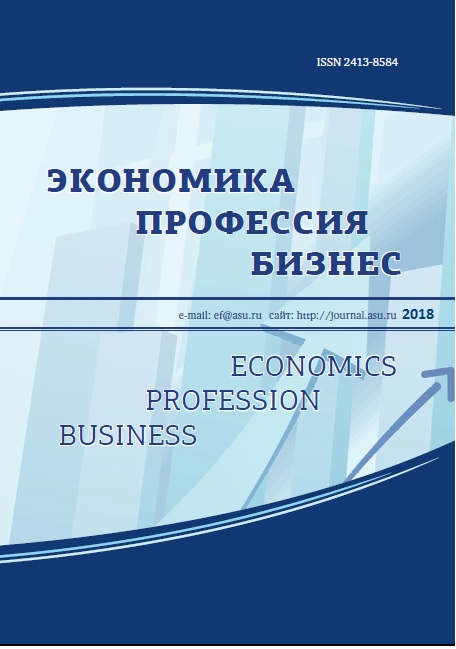ACCOUNTING FOR IMPAIRMENT OF ASSETS IN ACCORDANCE WITH INTERNATIONAL FINANCIAL REPORTING STANDARDS
Abstract
The value of assets is subject to changes annually, so, for each reporting date, a new book value is determined based on fixed assets, which results from the initial cost adjusted for depreciation and possible impairment losses. The difficulty in determining the new book value of fixed assets arises from the determination of whether there is a possible impairment of the asset. An entity should track annually whether there is an impairment, whether a real decrease in value has occurred, how it will affect the financial statements, and what the outcome of management decisions will be. The article discusses the concept of "impairment" and the methods of depreciation of various assets.Downloads
Metrics
References
Голикова О. В., Адушева А. Ю., Муравицкая Н. К. Проблемы учета и аудита основных средств и варианты их решения в соответствии с международными стандартами // Вестник Волжского университета имени В. Н. Татищева. 2017. № 4, т. 1. С. 1-9.
Дружиловская Э. С. Современные проблемы оценки активов в российском бухгалтерском учете // Вестник Нижегородского университета им. Н. И. Лобачевского. Серия: Социальные науки. 2016. № 1. С. 29-37.
Федеральный закон Российской Федерации от 27 июля 2010 г. № 208-ФЗ «О консолидированной финансовой отчетности» // Гарант. URL: http://base.garant.ru/12177506/.
Международный стандарт финансовой отчетности (IAS) 36 «Обесценение активов» / Министерство финансов Республики Казахстан. URL: http://www.minfin.gov.kz/irj/portal/anonymous/.
Международный стандарт финансовой отчетности (IAS) 2 «Запасы» / Министерство финансов Республики Казахстан. URL: http://www.minfin.gov.kz/irj/portal/anonymous/.
Международный стандарт финансовой отчетности (IFRS) 9 «Финансовые инструменты» / Министерство финансов Республики Казахстан. URL: http://www.minfin.gov.kz/irj/portal/anonymous/.
Попова Л. А. Учет обесценения активов // Вестник Ульяновской государственной сельскохозяйственной академии. 2009. № 1 (9). С. 30-35.
REFERENCES
Golikova, O. V., Adusheva, A. Yu., Muravitskaya, N. K. (2017) Problems of Accounting and Audit of Fixed Assets and Options for their Solving in Accordance with International Standards. Bulletin of Tatishchev Volzhsky University, 4, vol. 1, 1-9 (in Russian).
Druzhilovskaya, E. S. (2016) Current Problems of Valuation of Assets in Russian Accounting. Bulletin of the N. I. Lobachevsky Nizhny Novgorod University. Series: Social Sciences, 29-37 (in Russian).
Federal Law of the Russian Federation of July 27, 2010 No. 208-FZ "On consolidated financial statements". URL: http://base.garant.ru/12177506/(in Russian).
International Financial Reporting Standard (IAS) 36 "Impairment of Assets". URL: http://www.minfin.gov.kz /irj/portal/anonymous/(in Russian).
International Financial Reporting Standard (IAS) 2 "Stocks". URL: http://www.minfin.gov.kz/irj/portal/ anonymous/(in Russian).
International Financial Reporting Standard (IFRS) 9 "Financial Instruments". URL: http://www.minfin.gov.kz/ irj/portal/anonymous/(in Russian).
Popova, L. A. (2009) Accounting for the impairment of assets // Bulletin of the Ulyanovsk State Agricultural Academy. 2009. № 1 (9). from. 30-35 (in Russian).
Copyright (c) 2018 Economics Profession Business

This work is licensed under a Creative Commons Attribution 4.0 International License.
Economics Profession Business is a golden publisher, as we allow self-archiving, but most importantly we are fully transparent about your rights.
Authors may present and discuss their findings ahead of publication: at biological or scientific conferences, on preprint servers, in public databases, and in blogs, wikis, tweets, and other informal communication channels.
Economics Profession Business (EPB) allows authors to deposit manuscripts (currently under review or those for intended submission to EPB) in non-commercial, pre-print servers such as ArXiv.
Authors who publish with this journal agree to the following terms:
- Authors retain copyright and grant the journal right of first publication with the work simultaneously licensed under a Creative Commons Attribution License that allows others to share the work with an acknowledgement of the work's authorship and initial publication in this journal.
- Authors are able to enter into separate, additional contractual arrangements for the non-exclusive distribution of the journal's published version of the work (e.g., post it to an institutional repository or publish it in a book), with an acknowledgement of its initial publication in this journal.
- Authors are permitted and encouraged to post their work online (e.g., in institutional repositories or on their website) prior to and during the submission process, as it can lead to productive exchanges, as well as earlier and greater citation of published work (See The Effect of Open Access).









